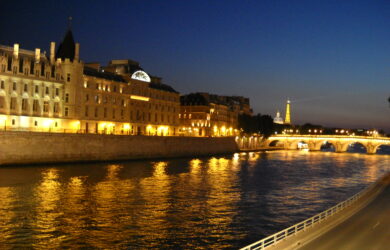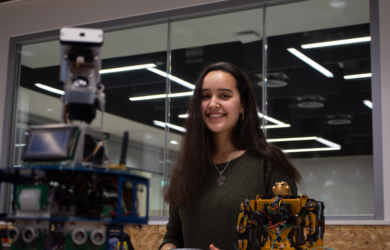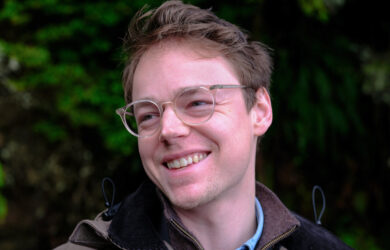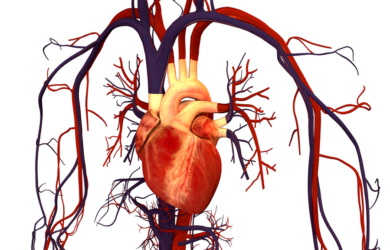Rachel Reckin will start a PhD in Archaeology in the autumn studying paleo-climatic reconstruction and archaeology in mountain regions.
As climate change causes worldwide temperature rises, melting patches of ice and snow are beginning to yield artefacts that have lain frozen beneath the surface for thousands of years.
These may hold the secret to how humans impacted and adapted to climate change in prehistoric times. Rachel Reckin is one of a growing number of archaeologists who are interested in studying paleo-climatic reconstruction and archaeology in mountain regions.
She says: “There’s lots of archaeology in the mountains and no-one talks about it. It is hard to access and there’s a bias that there’s nothing much there, but we are finding that that is not the case.”
Her PhD in Archaeology, which she begins in October, will look at how people thousands of years ago adapted to climate change. While holding down a job as an archaeologist in a national forest, she has been working on a project in Glacial National Park in Montana during her holidays. “We are not just finding artefacts, but paleo-biological material like ancient trees,” she says.
They can date this organic material from the ice, and can calculate from how tall the the types of samples grew and from coring the ice what the climate must have been like. They can also do a pollen analysis of plants. Researchers can then correlate the more precise ideas they have about climate change over a particular period in that region with human activities to see what impact humans had and how they responded to change. At Cambridge she will continue this work, but will focus more specifically on two mountain ranges and near Yellowstone National Park. She will do high altitude surveys as part of an analysis of what was driving increased use of high altitude areas thousands of years ago.
Libby
Rachel combines her archaeological interests with an active involvement in community affairs in her home state of Montana. Rachel’s family has lived for generations in Libby, a small town of just over 2,600 inhabitants in northwestern Montana 90 miles away from the nearest large town.
Libby was home to a vermiculite mine which was closed when Rachel was three. In 1999 a story broke in a Seattle newspaper about the health risks of asbestos-contaminated land in Libby caused by the mine. When Rachel was away at college the extent of the contamination became clear. WhileRachel was growing up asbestos wasn’t mentioned, but prior to the clean-up, which is almost complete, the town was considered one of the most contaminated sites in the US. When she returned home, the local Centre for Asbestos-Related Disease had over 4,000 patients and several hundred people are said to have died from asbestos poisoning.
Anger about the situation was growing, but there was no clear villain to blame, says Rachel, who herself is tested as part of a study on children who grew up when the mine was open. “There was good reason to be angry, but there was a lot of misinformation around,” she says. “I thought what we needed was unbiased information.” She started up the Libby Legacy Project with the aim of going into schools and educating the community about the history of the mine and its legacy. She also began an oral history project, talking to miners and others in the community, some of whom died after giving interviews. The Project is now looking to put together an exhibition at a local museum. “I hope we have made a difference,” says Rachel. “The aim was to ensure we as a community confronted the issue not just in a spirit of anger, but one of hope.”
Early life
Rachel, whose parents are both teachers, has long had an interest in community work. At high school she was involved in several community-based organisations through her church and she and her older sister joined Habitat for Humanity, an international development charity that aims to break the cycle of poverty by eliminating poverty housing and homelessness. Rachel is on the board of a local affiliate of the organisation and is involved in making decisions about acquiring and building property and in fundraising. The organisation builds a local home every other year and helps others to renovate and repair their homes so they can have safe, decent places to live.
Although she played a lot of sport at high school, Rachel, a keen oboe player, soon realised she stood more chance of getting a music scholarship than a sports one. She won a substantial music scholarship to the University of Puget Sound in Washington which meant she had to rehearse for two hours a day and take part in concerts almost every weekend. Rachel was interested in a wide range of subjects, but by the end of her second year had settled on a major in English. In her third year she went to the University of Aberdeen in Scotland as part of a study abroad programme. Her family has some Scottish heritage and the programme she chose meant she could keep all her music and other academic scholarships.
Rachel loved Scotland and joined the mountaineering club. It was while she was with a friend visiting a castle and archeological site that she reached a turning point in her academic career. It was raining and the two were in a rental car. Rachel got out and started crawling through the archeological ruins. “I was as happy as could be and got back into the car where my friend was,” she says. “I had been having a crisis about whether English was the right subject for me. My friend asked why didn’t I try archaeology. I was really interested in archaeology and had taken courses on it. I had always been interested in it while I was growing up, but had never thought of it as something I could do as a career. We were a very outdoors family. We would go walking and I would see an arrowhead on the ground and imagine people in pre-history. I read National Geographic regularly and the archaeology features were always my favourite ones. I visited archaeological sites. When my friend asked that question it was an epiphany.”
Archaeology
When she returned to the US she was in her fourth year and it was too late to change her major. In any event the University of Puget Sound did not have an archaeology major. She would have had to do an additional year and her scholarships would have run out. Instead she took as many relevant courses as she could and decided to apply to do a masters in archaeology. “People thought I was insane. I had no experience. I hadn’t been on any digs, but I was determined,” says Rachel. She did a field school with the University of Montana in Yellowstone National Park which she really enjoyed. She then met Professor Bob Kelly at the University of Wyoming. He is a well-known archaeologist, but she didn’t know it at the time. She spoke to him for a couple of hours and must have done a good job convincing him of her passion for and potential in archaeology. He fought with his department to admit her for a masters. “I think he had to convince some of the faculty I could do it,” she says.
Rachel was awarded a fellowship for her masters and also worked as a research assistant. Every summer of her student years she worked for the Forest Service and once she started her masters she focused on archaeology. When she graduated three years ago she applied for a local job in the Forest Service and has been working as an archaeologist covering 2.2m acres of forest, including Native American sites. Her work includes surveying areas before new projects are begun to ensure no damage is done to archaeological material. In addition, she also speaks at local schools and community groups about her work and about Native American history. “Children don’t hear about the people who lived here first. There is not a huge Native American population right in Libby so that history gets forgotten. I am passionate about bringing it to life,” she says.
Picture credit: Evan Thompson Photography.












